This episode is all about a world without plastic. What would that look like? Is it even possible?
Today, plastic is seen as one of our great environmental enemies. But it actually wasn’t always that way. Bradford Harris, a historian of science and the host of a podcast called How It Began: A History of the Modern World, and Susan Freinkel, a journalist and the author of Plastic: A Toxic Love Story, walk us through how plastic started out as a solution to unsustainable practices. Then we talk to Sherry Lippiatt, California Regional Coordinator for the NOAA Marine Debris Program, about what exactly is going on with garbage in the ocean. And finally I visit Danielle Trofe at her studio in Brooklyn, where she grows sustainable materials using mushrooms.
Further reading:
- Debbie Chachra on peak plastics
- “On a scale beyond all previous conceptions” [electronic resource] : plastics and the preservation of modernity
- Bradford Harris: Plastics and Sustainability
- Our ‘Toxic’ Love-Hate Relationship With Plastics
- 99 Percent Invisible: The Post-Billiards Age
- Plastic waste inputs from land into the ocean
- There Is No Island of Trash in the Pacific
- Global Plastic Production Rises, Recycling Lags
- Different Types of Plastics and their Classification
- Health risks posed by use of Di-2-ethylhexyl phthalate (DEHP) in PVC medical devices: A critical review
- How Stuff Works: bioplastics
- Taxation and Regulation of Plastic Shopping Bags in Botswana and South Africa
- GROW: A Lamp YOU Grow from Mushroom Mycelium
Flash Forward is produced by me, Rose Eveleth. The intro music is by Asura and the outtro music is by Hussalonia. The voices from the future this episode were provided by Lisa Pollak, Arielle Duhaime-Ross, Brent Rose, Victor Dorff and Mary Beth Griggs. The episode art is by Matt Lubchansky.
This episode was sponsored in part by:
- The Demon Crown, the latest novel by James Rollins.
- BetterHelp, convenient, affordable, private online counseling. Enter the invite code FLASH to get your first 7 days free
If you want to suggest a future we should take on, send us a note on Twitter, Facebook or by email at info@flashforwardpod.com. We love hearing your ideas! And if you think you’ve spotted one of the little references I’ve hidden in the episode, email us there too. If you’re right, I’ll send you something cool.
And if you want to support the show, there are a few ways you can do that too! Head to www.flashforwardpod.com/support for more about how to give. But if that’s not in the cards for you, you can head to iTunes and leave us a nice review or just tell your friends about us. Those things really do help.
That’s all for this future, come back next time and we’ll travel to a new one.
▹▹▹▹▹▹▹▹▹▹▹▹▹▹▹▹▹▹▹▹▹▹▹▹▹▹▹▹▹▹▹▹▹▹▹▹▹▹▹▹▹▹▹▹▹▹▹▹▹▹▹▹▹▹▹▹▹▹▹▹▹▹▹▹▹▹
TRANSCRIPT
Rose: Hello and welcome to Flash Forward! I’m Rose and I’m your host. Flash Forward is a show about the future. Every episode we take on a specific possible… or not so possible future scenario. We always start with a little field trip to the future, to check out what’s going on, and then we teleport back to today to talk to experts about how that world we just heard might really go down. Got it? Great!
This episode we’re starting in the year 2040.
INTRO:
NPR Host [[Lisa Pollak]]: President Adam Susan signed an executive order today banning the use of all plastics, in a move that shocked environmentalists and plastics manufacturers alike. The order comes with little explanation or direction — it does not specify which types of plastics should be banned, or how the ban should be enforced. As with so many recent executive orders, right now, no one is sure what happens next. Swanhilda Coppelius, from member station KJZZ reports.
Reporter [[Arielle Duhaime-Ross]]: President Susan didn’t take questions after signing his executive order, but his brief speech before signing the document gave a few clues as to the motivation behind the order.
Adam Susan [[Brent Rose]]: “Our nation is strong because thanks to our independence. We rely on no one. And not only are we seeking energy independence, we must also seek materials independence. We cannot waste a drop of petroleum, our most precious commodity.”
Reporter: President Susan also poked fun at environmentalists as he signed.
Adam Susan: “They think I’m such a bad guy! Always with the bad man, bad man. Well how about this? I hope they have the decency to thank me.”
Reporter: But what happens next, is unclear. John Rodriguez is a spokesperson for Hexxus Plastics, a trade organization that represents companies who manufacture plastic goods.
John Rodriguez 1 [[VIctor Dorff]]x: It’s too early to say really. Our member companies make hundreds of thousands of types of plastics that go into everything from cars to your hospital equipment.
Reporter: And Rodriguez was quick to defend his industry’s worth to the American Federation.
Rodriguez: The plastics industry employs over 900,000 American workers, and brings $373 billion dollars. We look forward to a dialogue with the president to find a way to achieve his goals without destroying such a booming industry.
Reporter: Environmental groups are also scratching their heads at the order.
Janet Evason [[Mary Beth Griggs]]: Obviously, uh, we’re excited about anything that might have a positive impact on the environment?
Reporter: Janet Evason works at One Earth World, an environmental group that has been lobbying for plastic bag bans across the country.
Janet Evason: We’re just not, um, totally clear on what this order means. For now I guess we’ll take it as a victory since, I guess no plastic means no plastic bags!
Reporter: The president did not take questions after signing the order. Now, lobbyists and manufacturers will just have to wait and see whether President Susan enforces the ban or not. Swanhilda Coppelius, reporting from Phoenix Arizona.
>>>
Rose: So in this future, plastic is banned. All plastic! Which is… a lot of stuff. Take a look around you right now — there’s probably tons of plastic. The coating of your desk, the light fixtures, the electrical wires in the walls, your coffee mug, your computer monitor, your mouse, your steering wheel, the little nubby bits at the end of your shoelaces — which I recently learned have a name! They’re called aglets.
Anyway, for most people on the planet plastic is a part of their everyday lives. The first thing you touched coming out of the womb was probably made of plastic in the form of latex gloves on the hands of whoever delivered you.
Susan: There are hundreds if not thousands of different plastics. So we’re thinking about the stuff that’s used in soda bottles or we’re thinking about what’s in your hair brush or which is nylon or we’re thinking about that clear hard plastic that is now in some car windows polycarbonate or we’re thinking about vinyl.
Rose: This is Susan Freinkel, the author of PLASTIC: A Toxic Love Story. Today’s plastics can come in almost any form. They can be soft or rigid, clear or opaque, thick or thin.
Susan: What they all have in common is they are polymers which means they’re made mostly from fossil fuels and they’re these very very big molecules. So I always tell people think of it like you know beads on a necklace and whether the beads are packed closely together or strung out far apart or have little dangly things or are big or square or circular. All of those are going to make the necklace look and act different.
Rose: Plastic is everywhere, and plastic is bad. That’s something I think many people have come to accept. Norman Mailer once wrote that plastic has come to represent “the social equivalent of cancer.” And all across the United States there have been regular pushes to ban all kinds of plastic. Plastic bags, styrofoam containers, toys, baby bottles. In 2008 alone there were over 400 pieces of plastics-related legislation introduced at various levels across the United States.
Brad: Plastics are sort of the ultimate symbol of unsustainability. They’re sort of the physical side of our unsustainable exploitation of fossil fuels petroleum and coal.
My name is Brad Harris. I have a Phd. in the history of science and technology from Stanford University
Rose: Brad also has a podcast called How it Began: A History of the Modern World. And at Stanford, his dissertation was about how and why plastic became ubiquitous.
Brad: People see plastic in the ocean or on the beach or in landfills. Plastic doesn’t break down it sticks around for thousands of years. That is clearly the sort of epitome of the unsustainability of our material culture and so plastic is the problem.
Rose: The thing is, that’s not how it used to be. In fact, at the beginning, plastic was a solution to our environmental problems.
Brad: Using natural materials was how humanity did its business for thousands of years and time after time. You can see first local communities and then nationally and then globally especially as economies grew and capitalism really got going. Natural materials were overexploited, of course wood but also a lot of whale products so whale oil and baleen and bone was used to make all kinds of products and during early industrialization there were things like tortoise shell.
Rose: To try and combat this over exploitation, people started looking for replacement materials for things like ivory.
Brad: So basically the second half of the 1800’s you know a lot of people that were involved are aware of the ivory trade and there were some of the earliest photographs ever to be taken were taken of Pyles mountains of elephant tusks and people were appalled at this and not to mention just beyond the emotional problem the price of ivory was skyrocketing. And so especially during the Civil War in the United States imports of ivory religious dried up and ivory might seem sort of like an you know an insignificant material but think of it and especially in America ivory was found in every single bar in the form of billiard balls and piano keys and every church in the form of piano keys. So this was a really important material and there was you know a couple of different companies in the United States involved in refining and manufacturing ivory for these products and they were getting desperate in the 1860s due to a lack of supply.
Susan: So a billiards ball manufacturer put out an ad asking for you know any inventive genius to come up with a substitute and they would pay ten thousand dollars.
Rose: That’s Susan again.
Susan: And that ad was spotted by this guy named John Wesley Hyatt who was sort of an amateur inventor and he built a workshop behind his house and he started you know tinkering around with this and that different materials. And after a lot of trial and error he said he finally came up with this substance that he called celluloid because it was made from plants cellulose and kampfer. And celluloid was great because it looked like ivory could be made to look like ivory it also could be made to look like tortoise shell coral or Ebony.
Rose: Using cellulose, companies could make things like billiard balls and combs and piano keys without having to use ivory. And it wasn’t just ivory that prompted the invention of a plastic.
Susan: That was followed in 1907 by Bakelite and that was invented by this Belgian chemist named Leo Baekeland. And again he was looking for a substitute for a scarce or depleting natural resource. What he was looking to replace was lacquer
Rose: Did you know that laquer, or more specifically shellac comes from a beetle? I did not! But it turns out the shellac is a resin that is secreted by the female lac beetle, which lives on trees in India and Thailand. And in the early 1900’s, the United States was blasting through lacquer.
Susan: But lacquer also happens to be a great electrical insulator and in the early 20th century the United States is stringing up wire everywhere and rapidly electrifying. And they couldn’t get enough lacquer to insulate the wires so they were desperate for a an alternative material.
Rose: In comes Leo Baekeland,
Susan: And Backlund you know like Hyatt before him set up a workshop spend a lot of time trying to come up with something and he came up with this stuff for called Bakelite.
Rose: As soon as Bakelite was introduced, it was instantly adopted all over the place.
Susan: think of those old fashioned telephones the old black telephones that’s Bakelite. It was used in fountain pens it was used in buttons it was used in industrial gears. And of course you know electrical wires.
Rose: Which was great for the poor little lac beetle.
Brad: Shellac was hands scraped off of trees. Usually the tree was injured seriously in the process if not killed. This was a big problem. It wasn’t just the beetle. This was like forests across South Asia. Were being really really damaged. Bakelite actually became the go to alternative for Shellback and after bakelite we stopped using shlock and all that kind of exploitation of the beetle and those forests were that beetle lived.
Rose: There are tons of examples like these — plastics cut down on deforestation, tortoise hunting, pearl harvesting and even whaling.
Brad: At the risk of incurring an aneurysm and environmentalists petroleum save the whales. Once petroleum was developed enough to just completely replace the all of the commercial outlets that whale products had gone into. Populations started to recover.
Rose: Now, let’s not pat ourselves on the back too much, lots of whales are still in trouble. And a lot has changed since the early 1900’s — plastic has totally taken over. And in fact, that monumental rise in the use of plastics has introduced a new problem for marine creatures specifically.
Sherry Lippiatt: So when plastic gets into the marine environment it doesn’t ever fully dissolve or mineralize but it breaks down into smaller and smaller pieces.
I’m Sherry Lippiatt, the California regional coordinator for the no Marine Debris Program.
Rose: Marine debris is a catch all term for stuff in the ocean that shouldn’t be there.
Sherry: So it can be everything from tiny pieces of micro plastic up to consumer debris items lost fishing gear abandoned and derelict vessels.
Rose: Not ALL marine debris is made of plastic. But… most of it is.
Sherry: Plastic is typically the number one material type that’s found. And it usually ranges from about 70 to maybe 85 percent of the items that are found during these surveys are plastic.
Rose: Perhaps the most famous element of this marine debris program is the so called “Great Pacific Garbage patch.” For a long time, people described this garbage patch as an actual island of floating garbage in the ocean. But that’s not exactly right.
Sherry: So that garbage patches aren’t an island or like a really thick accumulation of plastic that you can see from space or walk on. It’s more of a peppery soup of plastic debris. So a lot of smaller plastic fragments.
Rose: Because of the way the currents in the ocean move, those plastic fragments tend to accumulate in two regions, the Western Garbage patch off of Japan, and the Eastern Garbage Patch halfway between Hawaii and California.
Sherry: And so it’s just an area of the ocean we’re more plastic tends to accumulate compared to other regions of the ocean and you can actually sail through these areas and not even know unless you tow a net and collect a sample.
Rose: Fish and other creatures often wind up consuming these little bits of plastic, and, unsurprisingly, that’s not good for them!
Sherry: A number of marine species have also been shown and found to have ingested debris. And so that can cause physical blockages or damage to the gut as well as creating a false feeling of fullness with you know the plastic is not providing any nutrition to these animals. So for example Albatros in the north northwestern Hawaiian Islands pretty much any any bird that’s found has significant accumulations of plastic in their gut just because of the way that the feed and forage on the stuff that’s floating at the surface which is where a lot of the plastic is found. Similarly I think there’s evidence that sea turtles will mistake for example a plastic bag for food.
Rose: Scientists know that individual animals ingest this stuff. But they actually still don’t have great data on what that means for entire species or even populations.
Sherry: So for example how many species of moncks Hawaiian monk seal are killed by marine debris every year and what impact does that have on their overall population?
Rose: So if there are these pooled regions of plastic floating at the top of the ocean, why not just invent a … marine roomba, and skim that plastic off?
Sherry: So these areas are constantly changing in size and shape based on the current weather conditions and the way that the currents are moving. And like I said it’s really not. It’s not concentrated so it really is very disperse over a really large area of ocean. So it would take an incredible amount of effort just to cover this area even once and all the while more and more plastic is being dumped into the ocean.
Rose: Instead of trying to build the world’s largest pool skimmer to use on our oceans, Sherry says we should stop throwing so much plastic in them in the first place. Which, okay, fair enough.
Sherry: So thinking about single use disposable items that we’re using everyday like straws or plastic cutlery or to-go boxes plastic bags and thinking of ways that we can switch to reusable items and just kind of cut off that waste stream.
Or…. we could just ban plastic. Like in this episode’s future! And when we come back we’re going to talk about all the ways that would change the world, and who is developing alternatives right now. But first, a quick break.
[[AD BREAK]]
Rose: I wanted to start this section with a big list of statistics about just how prevalent and huge the plastics industry is. It turns out that it’s actually hard to find data on ALL plastics because there are so many different kinds. The American Chemistry Council puts out an 80 page manual every year called The Resin Review that just talks about plastic resins. But here’s some information I could find:
According to the Plastics Industry Association, there are 18,000 plastic manufacturing facilities in the US, and the plastics industry in the US alone employs over 1 million people. According to the Worldwatch Institute, 299 million tons of plastic were produced worldwide in 2013.
Plastics are in credit cards, carpet backing, window and door frames, synthetic leather, film, irrigation pipes, fast food trays, video cases, coat hangers, CD’s, medical storage containers, paint, toys, pots for plants.
Think about your kitchen. Your pots and pans probably have plastic coating, your refrigerator has plastic shelving, your spatula has that rubbery, the containers that you buy things in: peanut butter, oil, sauces, yoghurt, chip bags. Your vegetables might have come wrapped in plastic. Your cheese is probably wrapped in a paper that has a plastic coating.
Or take cars for example. In the 1960’s, about twenty pounds of plastic was used for each car. Then, in the 1970’s, the US passed vehicle fuel economy rules, and manufacturers were pushed to make their cars more energy efficient. One way to do that is to make them lighter. And one way to make them lighter is, you guessed it! Use less plastic! Today, fifty percent of your car’s volume is made up of plastic. That’s about 336 pounds of plastic per vehicle.
This is all to say that without plastics, everything would change.
Susan: The idea the idea of banning plastic is ridiculous. I mean for one thing what are you banning? There isn’t a single plastic. There are a lot of different plastics. And so. So what is it that you’re banning.
Rose: That’s Susan Frienkel again, the author of PLASTIC, a toxic love story. And even if you try to get specific, and ban certain kinds of plastics, Susan says you might run into trouble.
Susan: Are you banning the plastic that’s used to make plastic bags. Well that’s also used to package produce that’s going to travel from you know Chile to Massachusetts in the winter. And the only way you’re going to be able to feasibly get it here and to be able to get it here cheap enough is by using plastic. That’s the only lightweight material that allow you to do it. Are you going to ban you know nylon? Well nylon is used in a lot of different stuff. You know that that means that we’re not going to have toothbrushes anymore made of nylon. They’re going to have to be made out of boar bristles. Do we have enough boar to make toothbrushes for 300 million people? Are you going to ban you know acrylic? OK so what are you going to use in the windows of planes because that’s not all glass.
Brad: If they say no more plastic period then our economy grinds to a halt.
Rose: That’s Brad Harris again.
Brad: If we want to consume materials the way that we do if we want our our entire basis of prosperity to be gross domestic product to be a measure of the things that we consume and that that has to grow every year by like some 2 3 4 or 5 percent and the more it grows the better we’re doing. If that’s our metric for prosperity in the modern world then plastic is the like the best way we’ve discovered so far the most efficient way we’ve discovered so far for getting away with that.
Rose: Aha, once again the true enemy here is capitalism!
One thing that’s really hard when we’re thinking about replacing plastics, is that a lot of the time plastics do things that we just don’t have any other way to do. Even when we know that there might be downsides and risks to a certain kind of plastic, we have to weigh those against the benefits. I think the best example of this is the vinyl blood bag.
Susan: Until you had blood bags you couldn’t have blood banking. You didn’t really have a way to collect blood and keep it and be able to use it for transfusions.
Rose: The blood bag was invented by a guy named Carl Walter, a surgeon and professor at Harvard Medical school in the 1940’s. At the time, the concept of blood banking was totally new, and actually was kind of controversial. Walter had established one of the first blood banks ever, at it lived in a basement at Harvard. Apparently the trustees at the university found the whole concept of storing a bunch of blood in a basement kind of weird. So Walter kept the whole thing kind of on the down low.
Anyway, this blood bank he had established, it had a lot of problems. The blood from donors was drawn through rubber tubes and deposited into glass bottles which had rubber stoppers. The problem with the rubber was that it allowed air and bacteria to get in, which you obviously don’t want.
So Walter went looking for a better way, and he hit on this material that was all the rage at the time called polyvinyl chloride.
Susan: And so he started working with that vinyl and he developed this bag which you know seemed to hold the blood really well seemed to preserve the blood really well and it didn’t break.
Rose: It was a revelation — but Walters colleagues weren’t totally sold. So Walter came up with an idea to really impress them.
Susan: And so you know to show it off he brought it to this meeting to show it off to other scientists and he stepped on the blood bag you know and like look see it doesn’t break.
Rose: The vinyl blood bag is a huge deal. Without it, blood banks probably wouldn’t exist today. And the bag found an immediate use on the battlefield.
Susan: The way in which it really first got used widespread was during the Korean War and the medics loved it because they could squeeze the bags to get the blood moving when they were treating men on the field and in the past they had had to use glass bottles which they had to hoist up to rely on gravity to get the blood flowing and then it was like this you know flag to enemy soldiers you know here I am and the you know soldiers on the other side were just that or shoot at the bottles.
Rose: I don’t think it’s hyperbolic to say that the vinyl blood bag has saved a LOT of people’s lives. According to the American Red Cross, every two seconds someone in the United States needs blood, and in a year 6.8 million Americans donate blood to blood banks. That number would be bigger if the FDA lifted their terrible ban on sexually active gay men from giving blood! Anyway, none of that could really happen without the vinyl blood bag.
But the blood bag is also a great example of one way that plastic has really helped save a lot of people. But it’s not a pure good either.
Susan: But soon after they started using plastic bags they discovered other researchers discovered that a chemical was leaking out of the vinyl. And it’s a chemical called a phthalate that is used in a lot of different vinyls in a lot of different ways. Places that vinyl is used it’s used to make vinyl soft and flexible and that light can reach out of final pretty easily and it was leaching into the blood and blood bags and therefore getting into people when they got blood transfusions.
Rose: Now we should be clear that this stuff is leaching into the blood in really, really small quantities. For an adult, this stuff is probably no big deal. But if you have, say, a premature baby who needs a blood transfusion or something, it could be an issue.
Susan: And there is some research suggesting that babies who get a lot of either blood from blood bags or medicines that are given through vinyl you know I.V. kits may have some effect from this chemical. Very subtle effects and we don’t really know what they are right now. [23.8
Rose: PVC manufacturers have disputed the idea that there are any risks for PVC blood bags. And right now, the studies still haven’t pinned down if the amount of phthalates that are leaching out are really having an adverse effect, so we don’t know. It does seem clear that if you need a blood transfusion it’s definitely better to take one, than to refuse because you’re worried about plastic.
Susan: I mean it’s hard, because I don’t want to freak people out. People shouldn’t be freaked out about this. I mean these are these are subtle effects.
Rose: Blood bags have one other issue too — the PVC they are made of is really rough on the environment.
Susan: if there’s any plastic I would like to get rid of polyvinyl chloride. It’s a terrible plastic it’s it’s it’s noxious and toxic in its manufacture. The only reason it really keeps being made is because it’s cheap. And the only way that it’s made useful in in sort of as a soft flexible material is has been through the addition of these chemicals that may interfere with our hormones. That’s a bad use of plastic that’s a bad plastic.
Rose: Blood bags are a great example of how hard it might be to replace plastics. Because even though people are aware that there might be some risk to these PVC bags, and even though people know that they’re toxic to produce, nobody has come up with a better version.
Susan: Ironically with the blood bag it’s a really tough issue because it’s acknowledged that phthalates get into the blood and blood bags. On the other hand the blood bank industry doesn’t want to get rid of the blood bags because that particular ballot is a really good preservative of blood better than any other that they’ve been able to find to date.
Rose: So if plastics were banned outright, you can say goodbye to blood banking. At least until someone figures out a better way. Now, you would also say goodbye to some really noxious and dangerous plastics, which would be great!
But you’d have to figure out a way to replace all of this stuff. You need to find alternative materials that aren’t made out of plastic.
Danielle Trofe: This is our Stock of lampshades,
Rose: Can I touch?
Danielle: Yeah please. Some of them are you know part of our first collection ever grown so there are more historic summer explorations and making planters or other little objects and all like kind of very in texture and fuzziness…
My name is Danielle Trofe I am a designer here in Brooklyn New York specializing in creating sustainable solutions at the intersection of science technology and design. So there is a new classification of designers are called bio designers. And what that it’s a kind of a loose term. But what that means is you’re working with biomaterials. And I work with mushroom materials.
Rose: Danielle makes stuff like lamp shades and planters out of this mushroom material.
Danielle: And what that is is it’s chopped up corn stalks and hemp so it’s a byproduct from the agriculture industry that’s been upcycling and it’s been combined with liquid mushroom mycelium
Rose: So mycelium is basically like the root structure of a fungus. And these mycelium webs can get really, really big.
Danielle: there’s one in and in Oregon in East Oregon that is 1500 football fields in length and a couple of thousand years old. It connects entire ecosystems together and distributes nutrients and water and can signal and communicate. It’s like it’s the internet and it looks just like the Internet if you see two identical pictures they look exactly the same. So one’s mycelium one is the human made Internet.
Rose: The key thing to know about mycelium is that it can grow and bind things together. Which is how Danielle is using it for her work.
Danielle: So as the glue so it’s spine it’s growing in molds which really tooling and that holds a certain shape or whatever we’re trying to achieve and it actually digests and binds to our waste and creates this lightweight soft and completely compostable material.
Rose: Sorry I’m smelling it.
Danielle: Oh please. And actually has like a slight fragrance a little bit organic really. I don’t know what the best way to describe it. So it’s super light. And it’s almost feels like a lamb’s ear. Like if you like in there it’s super soft.
Rose: So what is this stuff on the outside?
Danielle: That’s the mycelium. So it’s completely white. A little bit a little bit off wait and that none of that white existed when you first put it in the tooling.
Rose: It’s kind of hard to describe what this stuff feels like. Sometimes it’s rough, but if you let the mycelium grow thicker it makes this super soft, almost sticky but not quite sticky layer. It’s like, if you’ve ever felt the backside of a pelt — like the actual fur is on one side, but the flip side has this really soft almost fuzz on it. It’s kind of like that?
Rose: I think if I had this in my house I would just touch it all the time.
Danielle: That’s the other fun thing about the material is you know how often you want to interact with your lamp like that you know it to be touching and just pet your lamp at the end of the day. So I like that. I like that it’s like it’s a new way to interact with you know something that produces light which creates this other awareness of. How often do you have that light on. And you know it’s kind of this whole cycle.
Rose: Now, one mushroom lamp isn’t going to be the end of plastic. The molds for the lamp are still made of plastic, and the cord for the light is wrapped in it. But Danielle hopes that people will start really seriously considering alternatives in places they can.
Danielle: The lamp is just a demonstration of one of the one of the applications. So really the next step is letting people play with them letting them explore the possibilities and start you know brainstorming around what other places can this material live in their life. You know what other materials in their environment can it replace and serve those same functions so I think that’s really where the direction is going is how do we encourage this thought process of questioning.
Rose: And it worked for Danielle!
Danielle: So I through working with this material I became really interested in biomaterials in general and also just biology and science. So I ended up going back to school and getting a master’s degree completed in two weeks. And biomimicry.
Rose: Danielle isn’t the only one working on biologically derived materials, either. There’s a growing field of bioplastics and biomaterials. Danielle uses mushrooms, but other people are using things like cigarette butts, vegetable oil, the gas from landfills, and more.
Danielle: You’re already starting to see plastics that are created from captured carbon out of the air. You’re seeing plastics that are being made from bacteria or yeast. It’s like plastics in the 70s right here in that that glorious experimentation place where that it really is all about creativity and finding the application and trying to push the boundaries into being able to to achieve the results that you need for the function that you need.
Rose: But realistically, not everything can be made out of mushrooms, or vegetable oil, or yeast. If you swing the pendulum back to using only quote unquote “natural” materials to make things, you wind up back with the same issue that plastics tried to solve: using too many natural resources like wood and the secretions of bugs. Ultimately, it’s not really useful to talk about banning plastics, or even types of plastic. It’s more useful to talk about specific uses that do or don’t make sense.
Susan: I always talk about Styrofoam. You know we there there are discussions about banning styrofoam in places. I think San Francisco actually has banned styrofoam takeout containers so styrofoam is like an awful material environmentally. You know you get a styrofoam coffee cup and it breaks up and it gets out into the you know if it gets if it gets dropped on the street it breaks up into a million tiny little pieces that will be around for centuries. It’s an awful material.
But put it in that between the walls of a house it’s a great insulator. It’s a green material in building. It’s just a crappy material when it’s used to keep a cup of coffee warm for 10 minutes.
Brad: Plastic after all comes from the earth it’s oil you know. And oil is nothing more than degraded organic molecules from millions of years ago plants and animals that once lived. So it’s all kind of the same soup of material is just in these different forms. And so if I were in charge I would focus less on banning anything because really the most effective thing would be to ban certain behaviors rather than certain materials. And instead I would try to focus on how do we gain control over this sort of molecular waste stream to the point where we can fully recycle any kind of material.
Susan: And if we could create that kind of closed loose loop system both in terms of the waste that we produce that could be used to make plastics. And in terms of massively ramping up recycling and making sure that the plastics that we make are plastics that can be adequately recycled it could be it could be fantastic it could be like utopia!
Rose: It’s unlikely that we’ll ever live in a world without plastics. Unless of course there is some kind of apocalypse, but even then, the plastics we’ve made today will probably still exist, for better or for worse. And I hope that maybe I’ve convinced you that having some kinds of plastic around is a good thing. Just maybe not in the form of, say, a disposable cup that you throw away after one use. Stop doing that.
[[[music up]]
Flash Forward is produced by me, Rose Eveleth. The intro music is by Asura and the outtro music is by Hussalonia. The voices from the future this episode were provided by Lisa Pollak, Arielle Duhaime-Ross, Brent Rose, Victor Dorff and Mary Beth Griggs. The episode art is by Matt Lubchansky.
If you want to suggest a future we should take on, send us a note on Twitter, Facebook or by email at info@flashforwardpod.com. We love hearing your ideas! And if you think you’ve spotted one of the little references I’ve hidden in the episode, email us there too. If you’re right, I’ll send you something cool.
And if you want to support the show, there are a few ways you can do that too! Head to www.flashforwardpod.com/support for more about how to give. But if that’s not in the cards for you, you can head to iTunes and leave us a nice review or just tell your friends about us. Those things really do help.
That’s all for this future, come back next time and we’ll travel to a new one.

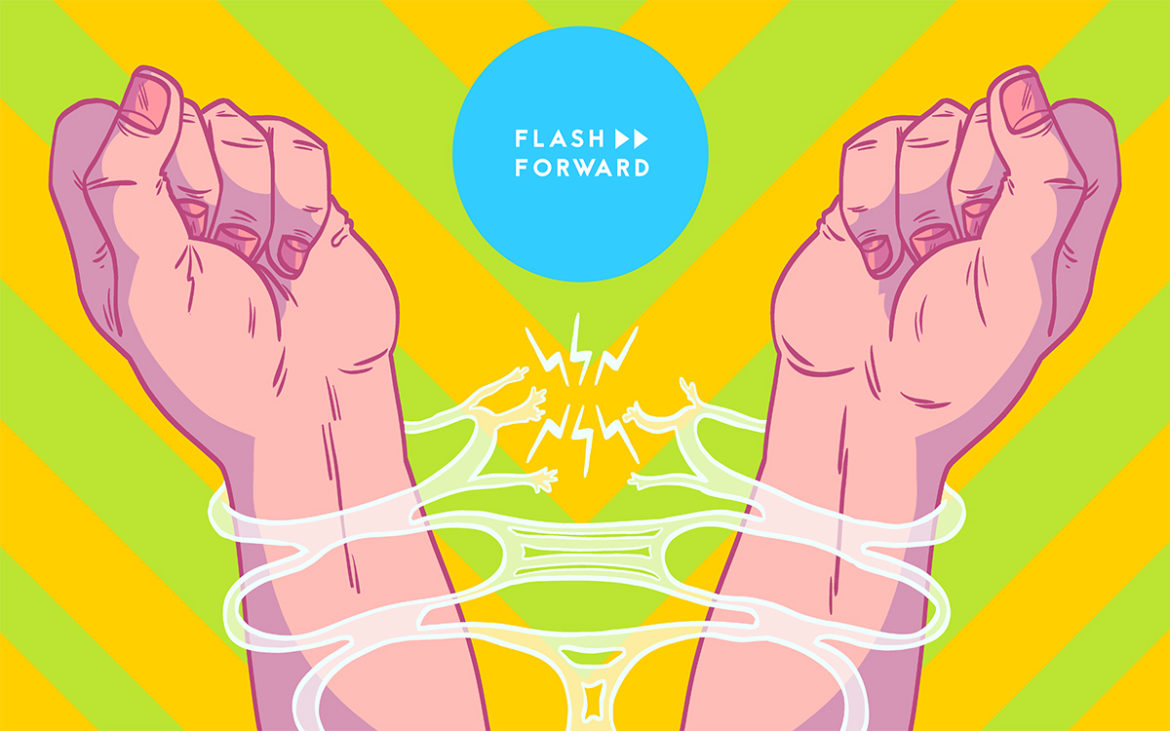
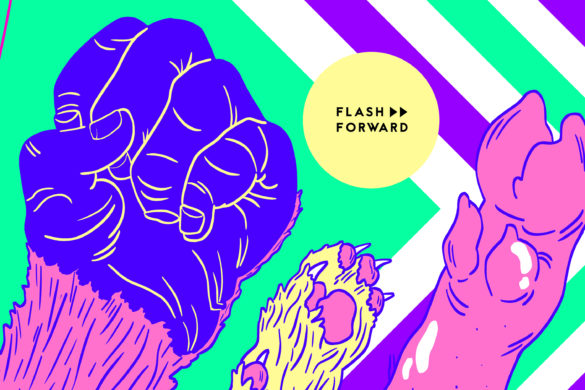
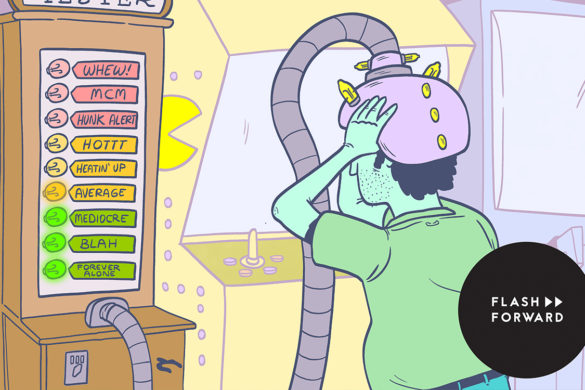
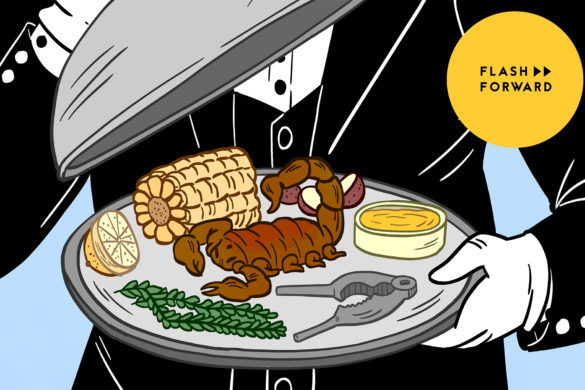
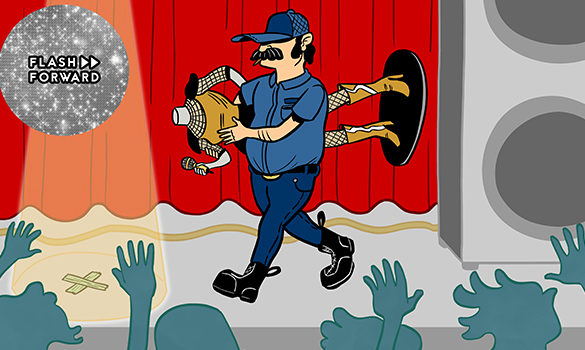
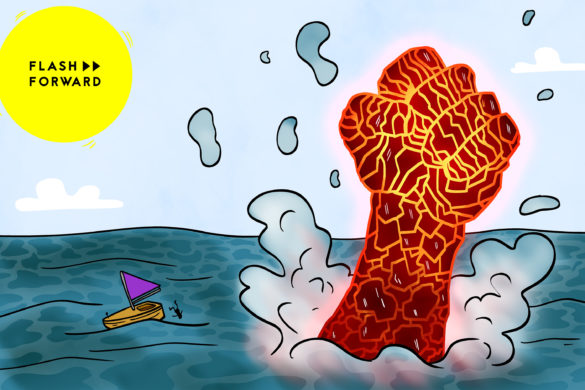
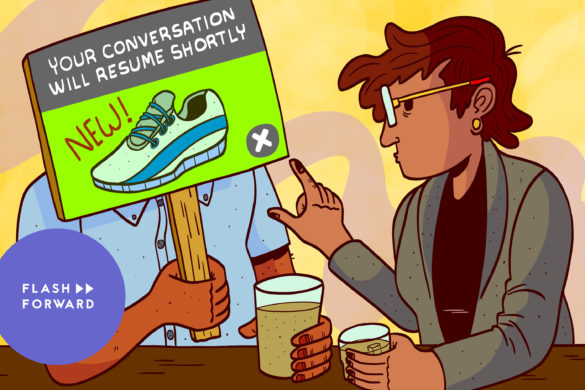
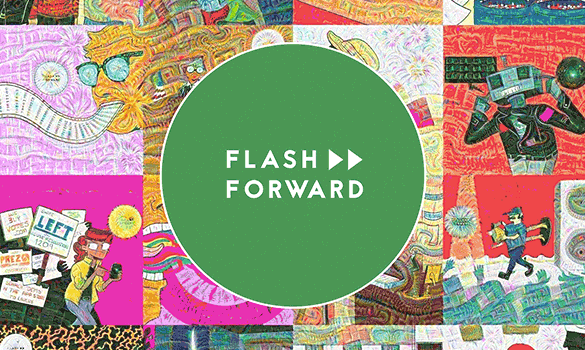
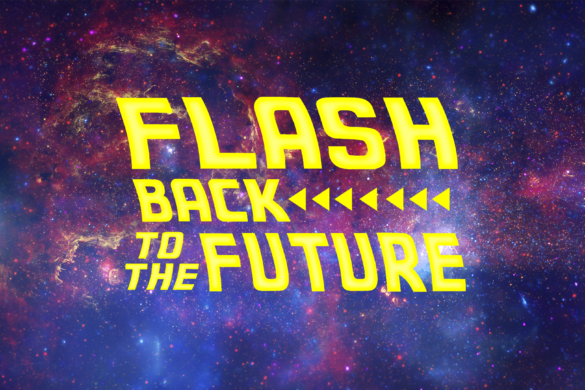
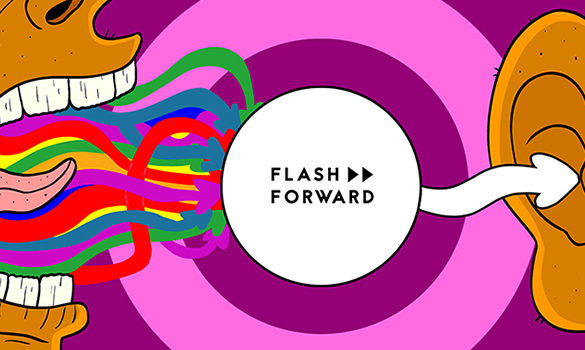
2 comments
Adam Susan is the name of the evil dictator in V for Vendetta (the graphic novel. The movie is a disgrace.)
[…] There’s No Great Future in Plastics […]